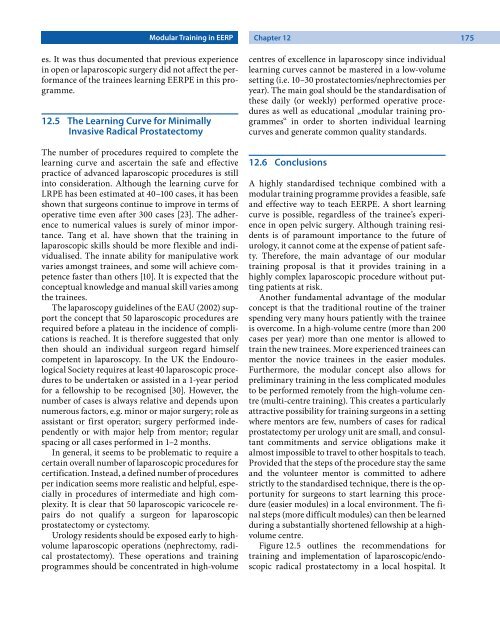7 - E-Lib FK UWKS
7 - E-Lib FK UWKS
7 - E-Lib FK UWKS
You also want an ePaper? Increase the reach of your titles
YUMPU automatically turns print PDFs into web optimized ePapers that Google loves.
Modular Training in EERP<br />
es. It was thus documented that previous experience<br />
in open or laparoscopic surgery did not affect the performance<br />
of the trainees learning EERPE in this programme.<br />
12.5 The Learning Curve for Minimally<br />
Invasive Radical Prostatectomy<br />
The number of procedures required to complete the<br />
learning curve and ascertain the safe and effective<br />
practice of advanced laparoscopic procedures is still<br />
into consideration. Although the learning curve for<br />
LRPE has been estimated at 40–100 cases, it has been<br />
shown that surgeons continue to improve in terms of<br />
operative time even after 300 cases [23]. The adherence<br />
to numerical values is surely of minor importance.<br />
Tang et al. have shown that the training in<br />
laparoscopic skills should be more flexible and individualised.<br />
The innate ability for manipulative work<br />
varies amongst trainees, and some will achieve competence<br />
faster than others [10]. It is expected that the<br />
conceptual knowledge and manual skill varies among<br />
the trainees.<br />
The laparoscopy guidelines of the EAU (2002) support<br />
the concept that 50 laparoscopic procedures are<br />
required before a plateau in the incidence of complications<br />
is reached. It is therefore suggested that only<br />
then should an individual surgeon regard himself<br />
competent in laparoscopy. In the UK the Endourological<br />
Society requires at least 40 laparoscopic procedures<br />
to be undertaken or assisted in a 1-year period<br />
for a fellowship to be recognised [30]. However, the<br />
number of cases is always relative and depends upon<br />
numerous factors, e.g. minor or major surgery; role as<br />
assistant or first operator; surgery performed independently<br />
or with major help from mentor; regular<br />
spacing or all cases performed in 1–2 months.<br />
In general, it seems to be problematic to require a<br />
certain overall number of laparoscopic procedures for<br />
certification. Instead, a defined number of procedures<br />
per indication seems more realistic and helpful, especially<br />
in procedures of intermediate and high complexity.<br />
It is clear that 50 laparoscopic varicocele repairs<br />
do not qualify a surgeon for laparoscopic<br />
prostatectomy or cystectomy.<br />
Urology residents should be exposed early to highvolume<br />
laparoscopic operations (nephrectomy, radical<br />
prostatectomy). These operations and training<br />
programmes should be concentrated in high-volume<br />
Chapter 12 175<br />
centres of excellence in laparoscopy since individual<br />
learning curves cannot be mastered in a low-volume<br />
setting (i.e. 10–30 prostatectomies/nephrectomies per<br />
year). The main goal should be the standardisation of<br />
these daily (or weekly) performed operative procedures<br />
as well as educational „modular training programmes“<br />
in order to shorten individual learning<br />
curves and generate common quality standards.<br />
12.6 Conclusions<br />
A highly standardised technique combined with a<br />
modular training programme provides a feasible, safe<br />
and effective way to teach EERPE. A short learning<br />
curve is possible, regardless of the trainee’s experience<br />
in open pelvic surgery. Although training residents<br />
is of paramount importance to the future of<br />
urology, it cannot come at the expense of patient safety.<br />
Therefore, the main advantage of our modular<br />
training proposal is that it provides training in a<br />
highly complex laparoscopic procedure without putting<br />
patients at risk.<br />
Another fundamental advantage of the modular<br />
concept is that the traditional routine of the trainer<br />
spending very many hours patiently with the trainee<br />
is overcome. In a high-volume centre (more than 200<br />
cases per year) more than one mentor is allowed to<br />
train the new trainees. More experienced trainees can<br />
mentor the novice trainees in the easier modules.<br />
Furthermore, the modular concept also allows for<br />
preliminary training in the less complicated modules<br />
to be performed remotely from the high-volume centre<br />
(multi-centre training). This creates a particularly<br />
attractive possibility for training surgeons in a setting<br />
where mentors are few, numbers of cases for radical<br />
prostatectomy per urology unit are small, and consultant<br />
commitments and service obligations make it<br />
almost impossible to travel to other hospitals to teach.<br />
Provided that the steps of the procedure stay the same<br />
and the volunteer mentor is committed to adhere<br />
strictly to the standardised technique, there is the opportunity<br />
for surgeons to start learning this procedure<br />
(easier modules) in a local environment. The final<br />
steps (more difficult modules) can then be learned<br />
during a substantially shortened fellowship at a highvolume<br />
centre.<br />
Figure 12.5 outlines the recommendations for<br />
training and implementation of laparoscopic/endoscopic<br />
radical prostatectomy in a local hospital. It











![SISTEM SENSORY [Compatibility Mode].pdf](https://img.yumpu.com/20667975/1/190x245/sistem-sensory-compatibility-modepdf.jpg?quality=85)





